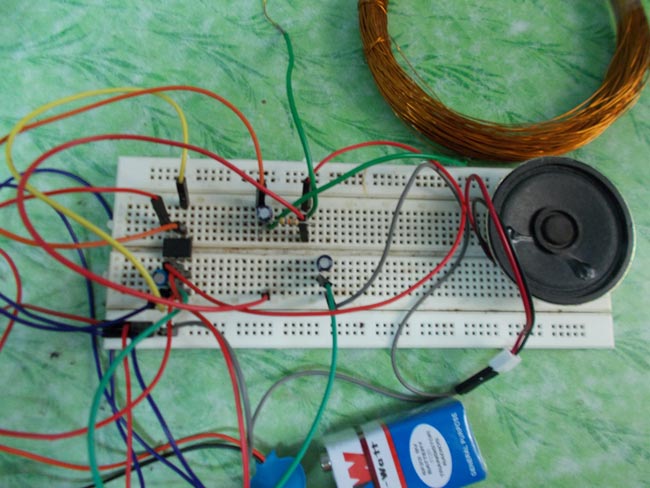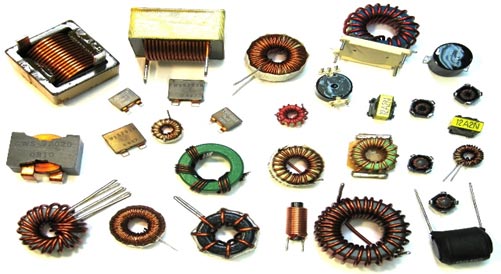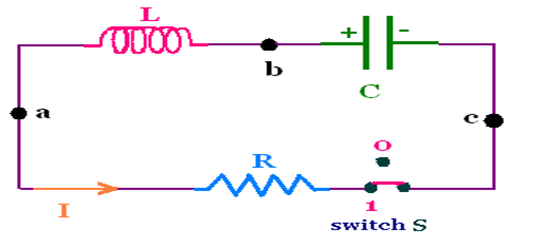
You can find a metal detector at airports, theaters and various other public places. They are used for the safety of people to detect anyone carrying a metal (Arms etc). In this project we are going to design a simple metal detector circuit. There are so many metal detector designs but most of them are complex in design so here we are going to design a simple metal detector circuit using 555 Timer IC.
Before going further we need to understand concept of inductor and RLC circuits. Let us first talk about inductors. Inductors are nothing but coils of enameled copper wire comes in different shapes and sizes. Based on various parameters the inductance of an inductor is calculated. In all of those parameters we are basically interested in core on the inductor as depending on the core, inductance value changes drastically.
In the figure below you can see the air cored inductors, In these inductors there will be no solid core. They are basically coils left in air. The medium of flow of magnetic field generated by inductor is nothing or air. These inductors have inductances of very less value.

These inductors are used when the need for values of few micro Henry. For values greater than few milli these are not a suitable one. In below figure you can see a inductors of ferrite core ,

When inductor coil is wound on a core may be ferrite or an iron core, the inductance of the coil increases enormously. This value is much more than the air cored one of the same size and shape.
Now for a RLC circuit as shown in figure, the reactance or impedance between terminals “a” and “c” depends on the values of L and C if the applied signal frequency is constant.

So if the inductance value changes the value of reactance or impedance changes. How these two concepts are used together for a metal detector circuit, is explained in working section of this project.
Metal Detector Circuit Components
- +9 supply voltage
- 555 IC
- 47KΩ resistor
- 2.2µF capacitor (2 pieces)
- Speaker (8Ω)
- 170Turns of 10cm diameter coil (any gauge would work)
Metal Detector Circuit Diagram and Working
The figure shows the circuit diagram of metal detector. The 555 IC timer here acts as a square wave generator and it generate pulses with frequencies audible to human. The capacitor between pin2 and pin1 should not be changed as it is need to generate audible frequencies.
In the circuit there is an RLC circuit formed by 47K resistor, 2.2µF capacitor, and 150turn inductor. This RLC circuit is the metal detection part. Now as mentioned earlier in previous section, a metal core inductor has a high inductance value over a air cored one.
Remember the coil wound here is a air cored one, so when a metal piece is brought near the coil, the metal piece acts as a core for the air cored inductor. By this metal acting as a core, the inductance of the coil changes or increases considerably. With this sudden increase in inductance of coil the overall reactance or impedance of the RLC circuit changes by a considerable amount when compared without the metal piece.
At first when there is no metal piece the signal fed to speaker causes some audible sound. Now with the reactance change around the RLC circuit the signal sent to speaker will no longer be the same as before, because of this the sound produced by the speaker will be of different to the first one.
So whenever a metal is brought near the coil, the impedance of RLC changes making the signal to change resulting in variation to sound generated in speaker. You can also check this Arduino based metal detector.
Common Tips:
- Enamel should be removed at the tips of coil for soldering connections.
- With different gauge we will have different RLC impedance, so one should experiment with resistance in RLC circuit for sensitive metal detection.
- The speaker can be of any type. But with resistance less than 8Ω, the timer might get heated.
- Use supply voltage higher than 5V.
Comments
Its not 2.2mf, its 2.2uF. Its
Its not 2.2mf, its 2.2uF. Its micro (u) not milli (m). And yes the value shouldn't be changed.
The circuit is present in the
The circuit is present in the description.
detector metal
i neded circuit board the detector and
the real value of capacitors 2,2 mf o 2,2 nano? thanks very
Metal detector
Can u help me out with design Steps? How to choose the values of R, L, C and inductance?
Metal detector
I now understand the concept behind metal detectors.
Thank you.
door frame metal detector
i want to make door frame metal detector. Can anyone help me?
metal detector
plz lets us know about theoritical design about this project
I didn't connect this circuit
I didn't connect this circuit, although I have question: does the voltage across the buzzer changes if a metal is brought near the coil?
Output Frequency of 555
Output Frequency of 555 changes, when we bring Metal near to the coil, so sound of Speaker changes according to the frequency.
i have 2 cd player,headphone,9volt battery,gluo,scrach tape....
i have 2 cd player and 1 9volt battery and headphone...can you help me make a metal detector
What transformer should be
What transformer should be used so that it connects directly in the power source?
You can try having 9v or 5v
You can try having 9v or 5v of regulated DC power supply form the 9-0-9 1A transformer
nice mister anyway can u give
nice mister anyway can u give us the video of how it works
thanks
Video is already given,
Video is already given, please check at the end of the Article.
can i use the coil of 5 cm diameter
can i use the coil of 5 cm diameter
No of Turns and diameter are
No of Turns and diameter are important in the coil, so use it as suggested in the article.
please can you explain to
please can you explain to what causes the continous noise or sound in the speaker.. need the answer as this a likely question in my project defense
detecting Distance
what is the Detecting distance ?
and if i want to increase it , what I can do.
my speaker doesnt turn on
the speaker doesnt make any sound what wud be the problem pls help urgent
help with parts specs
made circuit using 2.2uf50v 10uf50v capacitors 47k resistor ne555 ic 8ohm speaker on coil i used 0.1mm enameled wire 150turns of120mm diameter . the detactor produces a high pitch sound which does not change even when coil is swept over a metal object. pliz help with specific voltages of capacitors and specific resistance of search coil
HELP TO MAKE 10FEET DISTANCE METAL DETECTOR
I WANT TO MAKE METAL DETECTOR WHICH DETECT METAL FOR 10 FEET DOWN THE EARTH PLZ HELP ME
What is the function of 10
What is the function of 10 micro farad capacitor here...??
how circuit work
the 555 timer either sourcing or sinking a fixed amount of current from its pin 3,
so I see as the output is a fixed squarawave tone so the increasing of L coil will increase voltage on it that increasing current draining from pin 3 hence reducing tone....very simple ! I will build the circuit and examine it under oscilloscope and if there is time I will publish results here ...god willing...
Yes @hossameddeen, please
Yes @hossameddeen, please share the results of you findings when you are done :)
can it detect all types of
can it detect all types of metal or only iron metal?? plz tell...
I want clarification
Why there is a continuous sound occuring.can i know the reason
Because 555 timer is
Because 555 timer is generating a square wave which is causing the sound and bringing metal near to it will change the frequency of that square wave hence the sound will also change.
I can't find inductance in my
I can't find inductance in my country
My country stops import it
What should I do?
You can build it easily using
You can build it easily using copper wire.
I am a hobbyist of metal
I am a hobbyist of metal detecting.
Can this metal detector circuit detect all kinds of metal?
There might be large functional difference.
please send this l projec for me becouse I want to know it well
Hallo friend i like to learn this metal please send me all project until final thanks
replace indicator
Could we replace the speaker with and LED instead?
in this circuit diagram pin 2
in this circuit diagram pin 2 and pin 6 are connected.I think its only astable multivibrator. am i right sir ??can we design a metal detector using monostable multivibrator configuration where pin 6and pin7 are connected???
Its a smoothing capacitor to
Its a smoothing capacitor to filter noise. It is optional and hence you can ignore it if you cannot find a 10u cap
Circuit did not work.
I made the exact same circuit. The coil of 170 turns, 22 gauge copper wire, 10 cm diameter and all the other components were kept the same as mentioned, but it did not work. I've tried it multiple times but not even the slightest of change in noise occurs.
Help me out. What could be the probable mistake?
Hey, did you figure out the
Hey, did you figure out the same mistake because the same issue i'm also having.
Even i couldn't get the output.
I have coil of 500 turns remaining all specs are same.
Thanks for sharing this
Thanks for sharing this project. I was able to make a working copy with the specified components. I'm wondering if it would be possible to filter out the constant tone when no metal is near the coil by simply adding a basic RLC band stop filter between the output and the speaker. It would probably need to be a sufficiently high order one to retain the sensitivity, and band stop because both higher and lower frequencies should be able to pass (to detect both ferromagnetic e.g. iron and non-ferromagnetic e.g. aluminium). Please comment if you have tried something like this :) Also would be interested if someone had experimented with differently shaped coils (for example '8'-shaped) to improve the detection range.







can weuse 10 mf capacitor instead of 2.2 mf capacitor